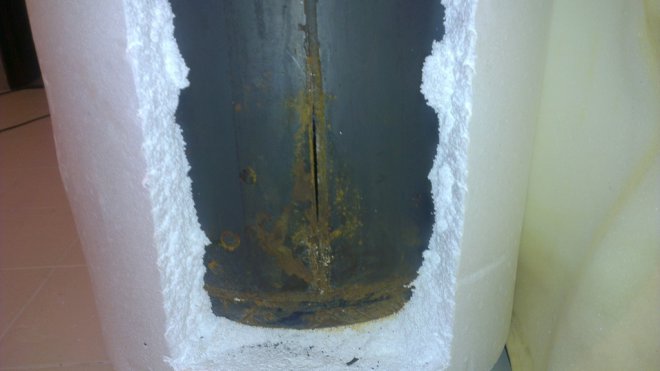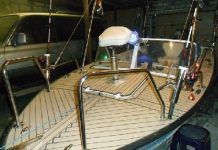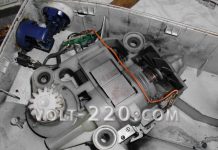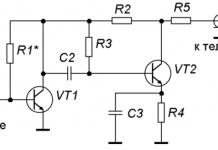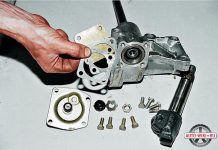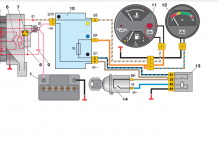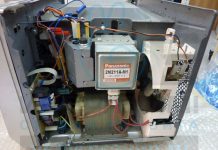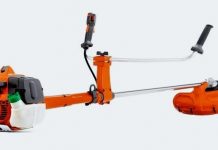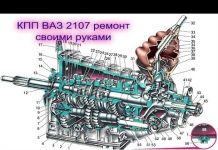In detail: DIY repair of a water heater tank from a real master for the site my.housecope.com.
An electric boiler is an effective solution to the problem of hot water supply for a private house. Such equipment, however, like any other, breaks down periodically.
If serious breakdowns have to be eliminated in a service center, then any more or less experienced craftsman can perform a small repair of the water heater with his own hands.
To minimize problems with the device, you should study its design and principles of operation. Usually, in private households, not flow-through, but storage models are used, which make it possible to use electricity more efficiently. Such a device consists of a heat exchanger tank, inside which a heating element is installed - a heating element, connected to the power supply.
An important part of the device is the thermostat. This element allows you to maintain a constant water temperature inside the storage tank. The water is piped to the heat exchanger. If its temperature is too low (and this is usually the case), then the thermostat gives a signal and turns on the heating element.
The water is heated until it reaches the required temperature. After that, the thermostat works again and turns off the heating element. Hot water is taken from the tank and replaced with cold water, the heating process is repeated over and over. This is a general diagram of the device and operation of a conventional storage water heater.
Flow models are arranged somewhat differently. They do not heat a static volume of water, but a stream. They use more powerful heating elements that start working when the water is turned on and stop when it is turned off. To study in more detail the operation and structure of a particular model, you need to carefully familiarize yourself with the accompanying technical documentation.
| Video (click to play). |
The heater tank is a sturdy stainless steel container, one or two millimeters thick. No matter how resistant this material is to corrosion, nevertheless, these processes periodically arise and develop, which leads to the flow of water from the device. One of the most common causes of such breakdowns is electrical corrosion.
To prevent it, you need to regularly, i.e. Replace the internally mounted magnesium anode annually. This element is specifically designed to prevent electrical corrosion. Over time, it wears out, and the owners of storage tanks lose sight of replacing this important part.
As a result, the tank, which has served well for some time, suddenly starts to leak. The incorrect state of the magnesium anode can also affect the state of the heating element. The outside of the storage tank is usually enclosed in a metal or plastic housing, and it also has a heat-insulating shell that prevents heat loss.
Damage to the outer shell and insulation is rare, usually due to careless handling of the device. Cracks and chips on the body of the water heater may not disrupt its operation, but this will lead to a deterioration in the properties of the heat insulator, and will negatively affect the functioning of the device as a whole.
Cold water inlet and outlet pipes - for hot water usually do not cause any problems if the installation of the heater is done correctly. Usually, a water heater is equipped with two thermostats, one of which is designed to control the water temperature, and the second monitors the state of the first device.
Sometimes a third thermostat is also used, which determines the good condition of the heating element. In any case, the broken thermostat will have to be completely replaced.There are capillary, rod and electronic types of thermostats. Their design is different, but the principle of their work is the same.
The insulating gasket not only serves to seal the connection between the elements of the water heater, it is also necessary as an electrical insulator. It is recommended to replace this element regularly at every maintenance of the water heater.
The thermostat shows exactly what temperature the water inside the device is heated to. If this element breaks down, the water heater will still perform its functions, although data on the degree of heating will not be received.
Breakdown of heating elements is a typical problem for both flowing and storage water heaters. This element works under high stress and therefore wears out quickly. If the power supply is connected, but the water in the tank does not heat up, most likely the problem has arisen with the heating element.
First, you should check if electricity is supplied to the heating element and the thermostat. In the places where the cable is connected, the presence of voltage is checked with a tester. If there is no voltage, you may need to replace the cable itself or check for a power outage throughout the house.
If there is electricity and the cable is working properly, then problems have arisen with the heating element, which will have to be replaced, or with the thermostat. To figure out what exactly broke, you need to remove the thermostat and check it with a tester. Testing the health of the heating element is carried out as follows. First, the measuring scale of the device is set to the interval of 220-250 V. Then the resistance is measured at the terminals connecting the heating element to the mains.
If there is voltage, disconnect the heating element from the network and check the potential at the terminals of the heating element. Lack of response from the tester will indicate that the device is defective. If there is a reaction, you need to continue the diagnosis. First, disconnect the water heater from the power supply. Then the heating element is disconnected from the thermostat so that the contacts of the heating element remain not isolated.
Tester contacts are applied to them and the reaction is monitored. If it is, the heating element is working, if not, it needs to be replaced. In this case, it does not matter what kind of numbers the tester produces, only the presence or absence of a reaction is important. These troubleshooting methods are suitable for both storage electric water heaters and flow-through models.
To check the serviceability of the thermostat removed from the water heater, you need to set the adjustment knob to maximum and measure at the inlet and outlet of the device. If the needle of the tester remains calm, i.e. its position does not change, which means that the thermostat is faulty and needs to be replaced.
If the arrow deviates, then you need to continue testing. Now you should set the minimum position on the thermostat and attach the test leads of the tester to the contacts. It will not be easy to continue the diagnosis alone, the probes will have to be fixed or asked someone to hold them in the correct position for a while.
After that, you need to take a lighter and heat the tip of the temperature sensor. If the thermal relay is triggered, the circuit will open, and the resistance on the tester's scale will sharply go down, then the thermal relay can also be considered serviceable. If the system does not respond to heating, then this element is damaged and needs to be completely replaced.
Occasionally, the water heater can stop working due to a blown thermal fuse as a result of dangerous overheating of the device. It is enough to correctly adjust the operation of the device for it to start working as usual.
If the check showed that both the heating element and the thermostat are in good order, most likely problems have arisen with the control board. It is almost impossible to repair such an element at home.It will have to be replaced with a new one, and you will have to use the help of a specialist who will help you set up the electronic equipment. Most often, you just need to contact the service center, where the required element will be selected and installed correctly.
A tank leak is a serious problem that cannot always be corrected on your own. In some models, either the tank or the entire heater will need to be replaced. Sometimes the leak can be sealed, but care must be taken to restore the integrity of the outer casing and the thermal insulation layer. Usually such measures are insufficient and short-lived, and soon the leak will reoccur.
The water heater tank most often leaks if:
- damage to the internal tank has occurred;
- the heating element has deteriorated;
- leaky gasket.
If water flows at the place where the heating element is attached, it may not be necessary to repair the tank itself. A special gasket is installed in this place, the leak can be caused by its damage. The gasket is replaced and thus the problem is solved.
A water heater tank leak usually occurs due to neglect or untimely maintenance, which also includes the replacement of the magnesium anode. Another common problem is lack of grounding. This can also lead to the development of corrosive processes and the occurrence of leaks.
If you need to replace the gasket or heating element, it is best to first dismantle the faulty element in order to take it with you and find an exact analogue. Obtaining parts by eye can result in unnecessary costs. This replacement is relatively straightforward. But if problems arise with the tank, you will at least have to contact the service center. Immediately it is necessary to find documents for the water heater and clarify the warranty periods and service conditions.
Regardless of the nature of the breakdown, before starting repair work, you first need to turn off the power supply, remove the protective cover, disconnect the wires, pipes and drain the water. Wall-mounted models are usually removed from the brackets. The protective cover that hides the place for connecting the electrical wires and the fastening of the heating elements may have a different position depending on the model.
On horizontal devices, such an element is usually located on the left, on vertical heaters - at the bottom, and on small models - in front. On some devices, you first need to unscrew the main mounting bolt located in the center. Sometimes this element is hidden under a decorative sticker.
After that, you need to carefully remove the thermostat, and then remove the tubes of the temperature sensor. They must be handled with great care. If the integrity of the thermosensor tube is broken, liquid filler will leak out. As a result, the water heater will simply have to be thrown away and a new device bought.
If there are stickers on the body with the serial number indicated, they must be kept, even if it interferes with the maintenance and repair of the product. This can affect the manufacturer's fulfillment of the warranty obligations, as well as facilitate the work of the service center employees.
The fact that there are problems in the operation of the device may indicate some changes in the mode of its operation. For instance:
- increasing the time for heating water to a predetermined temperature;
- the appearance of unusual sounds accompanying the operation of the device;
- the appearance of impurities in tap water, a change in its color, smell or taste.
If at least one of these signs is observed, the water heater should be cleaned immediately. To do this, you will have to perform the following operations:
- Disconnect the device from the power supply.
- Remove the protective cover.
- Disconnect the contacts of the electric wires.
- Shut off cold water supply.
- Remove residual water from the tank using a hose.
- Unscrew the screws that hold the heating element.
- Remove the heating element and descale it.
- Clean the inside of the drive from dirt and scale particles.
- Rinse the device thoroughly.
- Check the health of the magnesium anode.
- If necessary, replace this element immediately.
- Wait until the cleaned tank is completely dry.
- Install the heating element in place.
- Reassemble the device.
- Check the tightness of all fasteners.
- Connect the water heater to the power supply.
- Check for grounding.
The heating element should be removed from the tank carefully, the bolts may be too stubborn, sometimes the heating element is difficult to remove due to too much scale layer. The heating element is cleaned by mechanical or chemical means, as is the removal of contaminants from the tank. If a large amount of scale is found inside the device, you should consider revising the operating mode of the water heater.
This phenomenon is often observed when the device has been operating at maximum power for a long time. It is recommended to set the maximum heating temperature not higher than 60 degrees in order to increase the life of the device and reduce the number of breakdowns. If the body of the heating device shocks, it is possible that the heating element is deformed and ruptured, or there are breakdowns in the control system.
A detailed video on diagnostics of the condition, maintenance and self-repair of domestic water heaters can be viewed here:
It is not so difficult to repair a water heater when it comes to replacing some of its elements. In the event of a serious breakdown, it would be wiser to contact a specialized service center. Correct use of the device and its timely maintenance will save you many problems and costs.
According to BusinesStat estimates, about 22 million domestic water heaters are currently in use in Russia, and by 2014 their number will approach 25 million. That's a lot, isn't it? Many of these water heaters have been serving for more than a year, and sooner or later the owners will face the issue of repair. What, then, to do? Call the technician from the service center? Perhaps this is the easiest and most expensive way.
You can go the other way, i.e. repair the water heater with your own hands. How can this be done? Not so difficult as it seems at first glance, carefully read the purpose of the main elements, arm yourself with the necessary tools and, following the recommendations from the article, proceed with the repair.
Let's look at the main elements of electric water heaters, both storage and flow type. Let's make a reservation right away that we still won't repair the gas water heater - the cost of an error can be very high. Therefore, it is better to entrust the repair of gas water heaters to authorized service centers.
So, if we have to, for example, repair a storage-type Ariston water heater, we need to know its main components. The picture above will help us with this, on it all the elements are indicated and named. To repair the Termeks water heater with our own hands, we will take a closer look at their purpose in the boiler:
In addition to the above, some water heaters are equipped with electronic monitoring and control circuits. In the event of a failure, the boiler will not work, but at least basic knowledge of electronics is already needed to repair it. If they are, then in most cases, you can repair the Ariston water heater with your own hands. The description of the operation of the electronic circuit and the methods of repair are not included in the plans of this article, perhaps in the near future we will consider this too.
Schematic diagram of switching on a "conventional" boiler
If the problem is in the electronic board, it can be circumvented and the boiler will work. As you can see from the schematic, the board is connected in parallel with the heating element power supply circuit. If you want and have basic concepts in electrical engineering, you can turn it off and connect the circuit as in conventional water heaters.But if you do not have such skills or you doubt the success of your plans, you should not start experimenting.
The circuit for switching on a boiler with an electrical board is indicated by number 6.
Other designations: 1 - control thermostat; 2 - control thermostat; 3 - indicator of turning on the heating element, a light that glows when water heating is turned on; 4 - heating element; 5 - grounding.
The device of instantaneous water heaters is practically identical to that described above. The main difference is the absence of a storage tank and more powerful heating elements. Therefore, we will not consider the units of an instantaneous water heater and will not repeat ourselves.


Heating element for repair of water heaters Real
The water heater is included in the network, but the indicator lamp for the heating element does not shine and the water does not heat up? Then the procedure for determining the malfunction is as follows:
- We take a combined measuring device (tester), set it on the voltage measuring scale of 220-250V and make measurements at the terminals of the cable and thermostat connection, if the voltage is normal, we measure the potential directly at the heating element terminals. If the voltage at the terminals of the heating element is normal, most likely the heating element itself is out of order.
- We disconnect our water heater from the electrical network and put the tester on the resistance measurement scale (Ohm), disconnect our heating element from the thermostat (in most models, a rather simple procedure - we remove the terminals with wires so that the ends of the heating element are "bare"). We measure the resistance at the contacts of the heating element, while accuracy is not important to us, this is not a motor winding. If the element is working properly, the device will show us a certain amount of resistance, if there is no indication, we remove the heating element and go to the store for a new one, it cannot be repaired. You can find out in more detail how to replace the heating element in a water heater from the article on our website.
This procedure for determining a malfunction of a heating element is identical for all types of water heaters, both instantaneous and storage.
Signs of a malfunction of the thermostat and thermostat are the absence of the heating element turning on in the presence of voltage, as well as if the control thermostat is triggered. To check the operation of the thermostat, we will have to remove it, how - you can find out from the article, which describes the procedure for installing and repairing water heaters, it is on the website.
So, the thermostat was removed. We take the device, put it on the measurement of resistance (Ohm). Set the position of the adjusting knob to Max and measure it on the thermostat contacts (input / output). If our tester does not respond, the element is defective, it cannot be repaired. It will be necessary to purchase and install its analogue.
If the control thermostat is triggered, then the procedure for determining the malfunction is as follows. We put the removed thermostat in the Min position and fix the measuring probes of the device on the contacts, if you are not alone - let someone hold it. Take a lighter and heat the thermostat flask / rod. If it is working properly, the picture will be as follows: the thermal relay is triggered and opens the circuit, the resistance on the contacts should tend to infinity, i.e. such as if the probes of the device are spread apart. If this does not happen - the thermal relay is scrapped, we go to get a new one, because this item cannot be repaired.
The most common malfunction, in addition to the electrical components of the boiler, is a leak. There may be two reasons:
- tank leak;
- leak from under the flange, which secures the heating element.
The reasons that caused the tank to leak can be: lack of grounding (which accelerated electrical corrosion), lack of proper maintenance, natural wear and tear.
It is not possible to repair the tank for the following reasons:
- the outer casing and the tank are practically inseparable, dismantling, so that it is almost impossible not to damage the shell;
- the inner tank is usually made of stainless steel with a thickness of 1 - 2 mm or in more expensive models made of copper, in rare cases it is made of plastic. There is very little you can do with the latter. You can still tinker with a copper tank and try to solder it, but, as a rule, such tanks are very durable due to their increased resistance to corrosion. Welding such a thin stainless steel at home is not realistic, so you should not waste time and effort.
- to everything else, the modern coating of tanks in storage water heaters is glass enamel, which is damaged during welding. It is not realistic to restore it at home, which means that the leak is inevitable in the near future.
The only way out of this situation is to replace the internal tank with a new one if your model allows such a replacement and, moreover, if you find an analogue. But it will be easier to buy a new water heater.
If a leak is detected from under the flange, then there are no particular difficulties for repairing the Termeks water heater, or any other. It is enough to drain the water from the water heater, remove the gasket and visually determine its wear or damage. We take it with us and go shopping in search of a similar one. Changing and using the boiler further. By the way, Onyx offers pipeline parts, including steel flanges, at reasonable prices.
These are the main malfunctions of electric water heaters. As you can see, flowing ones will have less of them, but it also costs more.
Poor water quality is considered to be the main cause of boiler breakdown. Because of this, scale forms on the surface of the heating element, the inner walls of the tank are susceptible to corrosion, which in the future entails more serious consequences and expensive repairs in the service center. In addition, the water heater may stop working due to improper connection to the power supply and the hot / cold water circuits.
As for the latter, when connecting the boiler, it is imperative to install a safety valve between the branch pipe coming out of the tank and the cold water supply pipe, which will protect the tank from rupture during a water hammer. You should also make the connection according to the instructions and, no less important, do not confuse where-what is connected. Sometimes situations arise that, if installed incorrectly, the water heater does not collect water. Please note that you should not panic in this case. It is better to look again at how to properly connect the equipment to the pipes and, most likely, you will understand why your water is not collected.
So that you understand how to repair a storage water heater in different conditions, then we will separately consider how to repair all possible breakdowns with our own hands.
If the boiler does not heat the water to the required temperature, but still makes noise when turned on, it means that scale has formed on the heating element, which you need to clean yourself. This is not difficult to do, you just need to disconnect the equipment from the network, drain the water from the tank and disassemble the case to remove the heating element. You will not have any difficulties with disconnecting the plug from the outlet, but draining the water can make the repair a little more difficult. Immediately we recommend watching a video lesson, which shows a simple method for solving this problem:
After you empty the tank, you will need to disassemble the boiler yourself. To do this, carefully disconnect all fastons connected to the thermostat and unscrew the screws, which are usually 6 pieces.
During the removal of the heating element, a little more water will pour out, which remains in the tank. It is recommended to clean the heating element itself immediately, before it is wet and the scale deposits have not hardened. We recommend using special cleaning agents that can be sprayed onto the heater. After a while, the deposits are effortlessly scraped off with a wooden spatula or even a blunt knife.Also, for repairs, you can boil the heating element in a bucket with the addition of special acid to the water, which will effectively solve the problem. To get rid of limescale for sure, we advise you to use fine-grained emery paper ("sandpaper") to clean the tubes to a metallic color.
Simultaneously with the repair of the boiler, which heats the water for a long time or weakly, it is recommended to replace the magnesium anode, which protects the tank from corrosion. To do this, dismantle the worn out rod and purchase exactly the same one in order to replace it yourself!
After that, you need to assemble the boiler in the reverse order and check whether it was possible to repair the weak heating of the water. Do not forget that first of all you must fill the tank completely with water, then connect the plug to the mains and start.
We draw your attention to the fact that there is a situation when the boiler does not heat the water, because the heater is broken. In this case, self-repair is that you need to ring it with a multimeter, setting the resistance measurement mode. We will tell you about this below!
If the light on the boiler is on and the water does not heat up, then it is likely that the heater, which we talked about above, is not working. It is quite simple to check it at home, you need to install the tester probes on the contacts of the heating element and see the resistance on the display. With a working heater, the resistance can vary between 0.4-0.7, as shown in the photo below. If you see "1" on the display, then there is a breakage and you need to replace the part with a new one, because it is almost impossible to repair it.
By the way, if the boiler beats with current or when it is turned on, the RCD is turned off by itself, then the cause of the breakdown, again, is in the heater from which the leak occurs. You can check the malfunction by connecting one probe to the contact of the heating element, and the second to the tube itself. You will see “1” on the display, the part is in good order and there is no need for repairs, a minus value or too large - replacement is required. In more detail about how to check the heating element with a multimeter, we talked in a separate article.
Another reason why the boiler does not heat the water or, on the contrary, heats up very much, is the failure of the thermostat. You can check it in two ways - with a tester or a lighter. Everything is clear with the tester, you need to act according to a similar method, but as for the lighter, everything is more interesting here. First, dismantle the thermostat and press the button on it (it is circled in the photo below). After that, the copper contact of the thermostat must be heated. If after some time the button returns to its original position (knocks it out), the thermostat is operational. If the thermostat does not work, you can repair the boiler that does not turn off or does not turn on by replacing this part with a new one. I would also like to note that there is no need to drain the water to replace the thermostat on the water heater. It is enough just to disconnect the equipment from the network and disconnect all the supplied wires.
Also, sometimes there is a breakdown - the temperature is not shown on the display of the water heater or the display does not work at all. In this case, check all the elements of the circuit and if you do not find an open circuit, most likely the control unit has broken. You will not be able to repair electronics with your own hands in the absence of experience and knowledge, so you will have to take the electric water heater to a service center for repair.
If you notice that water is dripping from the boiler, it is not always possible to repair it yourself. It is good if the cause of the leak is the wear of the seal on the flange. In this case, the gasket must be replaced with the same size, which will allow the breakage to be repaired. The situation is much worse if the water heater leaks due to the wear of the tank itself. Some advise to glue or solder the holes, but, as practice shows, after a short period of time you will still have to say goodbye to the boiler, becausesuch leak repair methods are extremely short-lived.
That's all I wanted to tell you about DIY boiler repair. We hope that now you know what to do if an electric water heater is leaking, does not heat the water well or does not work at all. These devices do not have many problems and you can get rid of them by timely maintenance of the system. At least once a year, check the non-return valve and clean the heating element so that malfunctions bypass you!
It will be interesting to read:
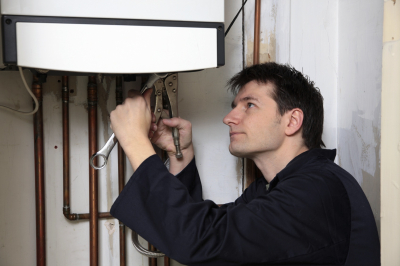
If an electric boiler breaks down in your apartment, then it is not at all necessary to call the master - you can figure everything out on your own, having straight hands and the simplest tools. If you call the master, his services will cost a round sum. In the end, storage water heaters have a simple design, so that self-repair of the boiler will not cause any difficulties.
Here is a list of the main boiler failures:
- Does not heat water;
- Heats the water poorly;
- The tank is leaking;
- The tank is not filled with water.
In fact, there is simply nothing to break here, especially if you are looking at a simple model without an electronic control module.
If you see water droplets or rust on the heating block of your boiler, then most likely it is leaking.
The most common breakdowns are leaks. Over time, water heater tanks begin to leak, even if they are equipped with corrosion protection. Stainless steel tanks are also susceptible to leaks, various seals wear out here. You can repair leaks at home - but first you need to figure out their causes.
Do-it-yourself water heater repair begins with its dismantling. But before that, you need to drain the water from the boiler using the methods described on our website. After the boiler is empty, it must be dismantled, disassembled and inspected. If the tank is flowing in an arbitrary place or at welds, soldering will be required using special fluxes and solders (for brazing steel, sold in hardware stores). For this, the damaged area is cleaned with sandpaper and wiped with a degreasing agent. And only after that you can start soldering.
Leaks can manifest themselves directly on the flanges. This means it is time to replace the gaskets. They can be purchased from some service centers or ordered through online stores. After replacing the gasket, you can forget about leaks. But even in this case, it is recommended to completely remove the tank and inspect it for integrity - it is quite possible that there are traces of other damage on it.
Many factors indicate that it is time to change the heating element. For example, the boiler may stop heating the water or start hurting with an electric shock. Replacing the heating element begins with draining the water and dismantling the boiler. Next, we open access to the heating element, take a test or a multimeter in our hands, check the resistance of the heater - it should vary from 40 to 70 Ohm, depending on its model. If the measuring device shows an open circuit, the heating element can be safely changed.
Set the multimeter to the audible dialing mode, and place its contacts on the heating element according to the diagram, if there is a squeak, then your heating element must be replaced.
If the boiler fights with current, you need to check the insulation resistance between its contacts and the body (one probe for the body, the second probe for one of the contacts). In megohmmeter mode, the meter should show infinitely high resistance. If it is tens or hundreds of ohms, then this indicates a breakdown. Since the heating elements are not repaired, they just need to be changed. To do this, we buy a similar model and install it in the boiler.
If the problem is related to a lack of heating or wild overheating, then the problem may lie in the thermostat. You need to check it with a multimeter and see how it reacts to heating.If a mechanical thermostat with a bimetallic plate is installed in the boiler, press the control button and heat the thermostat with a soldering iron or lighter. If the button bounces off after heating, then the thermostat is working. At the same time, you need to check the integrity of its contacts using an ordinary multimeter.
To clean the heating element of the water heater from scale, use the available means: a metal brush, a knife, etc.
Is your boiler making noise like an electric kettle? Does it heat water poorly, continuously consuming kilowatts of electricity? The scum covering the surface of the heating element is to blame for everything. It has a low thermal conductivity, so the heat from the heater is practically not transferred to the water. As for the noise, this is the noise of water in the thickness of the scale itself. Thus, all scale must be removed from here. We start repairing the boiler by draining the water, then remove the water heater from the wall, remove the heating element and start cleaning it.
Cleaning the heating element from scale can be done in different ways. The mechanical method involves removing the main layer of scale with your hands while it is still wet. After that, we take sandpaper in our hands and carefully remove the remnants of lime deposits from the heating element. As a result, we should get a clean and shiny heating element.
The chemical method involves the use of special reagents that dissolve or soften scale. These can be purchased at hardware stores, but be sure to check consumer reviews first. As for strong acids, it is better not to use them - they can damage the metal of the heater.
Do-it-yourself boiler repair is quite a simple matter. But if electronics "covered" in your boiler (refers to models with electronic control and various digital indicators), and there is no corresponding knowledge, you will have to call the wizard. We can also recommend periodic maintenance. They include:
- Descaling the heating element;
- Descaling the tank;
- Replacing the magnesium anode.
There is no need to wait until the boiler starts making noise or stops heating the water - arrange periodic cleaning of the heating elements, which will extend the service life of the water heater and prevent its premature failure (for example, the heating element can overheat).
Water heating tanks need periodic descaling and debris removal, what accumulates in their lower part - all this is removed through the flanges. If the garbage is not removed, bacteria will begin to multiply. It also affects the service life of the tanks. When cleaning the tank or heating element, it is necessary to pay attention to the inspection of the magnesium anode - it is quite possible that it is worn out and needs to be replaced.


According to BusinesStat estimates, about 22 million domestic water heaters are currently in use in Russia, and by 2014 their number will approach 25 million. That's a lot, isn't it? Many of these water heaters have been serving for more than a year, and sooner or later the owners will face the issue of repair. What, then, to do? Call the technician from the service center? Perhaps this is the easiest and most expensive way.
You can go the other way, i.e. repair the water heater with your own hands. How can this be done? Not so difficult as it seems at first glance, carefully read the purpose of the main elements, arm yourself with the necessary tools and, following the recommendations from the article, proceed with the repair.
Let's look at the main elements of electric water heaters, both storage and flow type. Let's make a reservation right away that we still won't repair the gas water heater - the cost of an error can be very high. Therefore, it is better to entrust the repair of gas water heaters to authorized service centers.
So, if we have to, for example, repair a storage-type Ariston water heater, we need to know its main components. The picture above will help us with this, on it all the elements are indicated and named.To repair the Termeks water heater with our own hands, we will take a closer look at their purpose in the boiler:
In addition to the above, some water heaters are equipped with electronic monitoring and control circuits. In the event of a failure, the boiler will not work, but at least basic knowledge of electronics is already needed to repair it. If they are, then in most cases, you can repair the Ariston water heater with your own hands. The description of the operation of the electronic circuit and the methods of repair is not included in the plans of this article, perhaps in the near future we will consider this too.
Schematic diagram of switching on a "conventional" boiler
If the problem is in the electronic board, it can be circumvented and the boiler will work. As you can see from the schematic, the board is connected in parallel with the heating element power circuit. If you want and have basic concepts in electrical engineering, you can turn it off and connect the circuit as in conventional water heaters. But if you do not have such skills or you doubt the success of your plans, you should not start experimenting.
The circuit for switching on a boiler with an electrical board is indicated by number 6.
Other designations: 1 - control thermostat; 2 - control thermostat; 3 - indicator of turning on the heating element, a light that glows when water heating is turned on; 4 - heating element; 5 - grounding.
The device of instantaneous water heaters is practically identical to that described above. The main difference is the absence of a storage tank and more powerful heating elements. Therefore, we will not consider the units of an instantaneous water heater and will not repeat ourselves.


Heating element for repair of water heaters Real
The water heater is included in the network, but the indicator lamp for the heating element does not shine and the water does not heat up? Then the procedure for determining the malfunction is as follows:
- We take a combined measuring device (tester), set it on the voltage measuring scale of 220-250V and make measurements at the terminals of the cable and thermostat connection, if the voltage is normal, we measure the potential directly at the heating element terminals. If the voltage at the terminals of the heating element is normal, most likely the heating element itself is out of order.
- We disconnect our water heater from the electrical network and put the tester on the resistance measurement scale (Ohm), disconnect our heating element from the thermostat (in most models, a rather simple procedure - we remove the terminals with wires so that the ends of the heating element are "bare"). We measure the resistance at the contacts of the heating element, while accuracy is not important to us, this is not a motor winding. If the element is working properly, the device will show us a certain amount of resistance, if there is no indication, we remove the heating element and go to the store for a new one, it cannot be repaired. You can find out in more detail how to replace the heating element in a water heater from the article on our website.
This procedure for determining a malfunction of a heating element is identical for all types of water heaters, both instantaneous and storage.
Signs of a malfunction of the thermostat and thermostat are the absence of the heating element turning on in the presence of voltage, as well as if the control thermostat is triggered. To check the operation of the thermostat, we will have to remove it, how - you can find out from the article, which describes the procedure for installing and repairing water heaters, it is on the website.
So, the thermostat was removed. We take the device, put it on the measurement of resistance (Ohm). Set the position of the adjusting knob to Max and measure it on the thermostat contacts (input / output). If our tester does not respond, the element is defective, it cannot be repaired. It will be necessary to purchase and install its analogue.
If the control thermostat is triggered, then the procedure for determining the malfunction is as follows. We put the removed thermostat in the Min position and fix the measuring probes of the device on the contacts, if you are not alone - let someone hold it. Take a lighter and heat the thermostat flask / rod.If it is working properly, the picture will be as follows: the thermal relay is triggered and opens the circuit, the resistance on the contacts should tend to infinity, i.e. such as if the probes of the device are spread apart. If this does not happen - the thermal relay is scrapped, we go to get a new one, because this item cannot be repaired.
The most common malfunction, in addition to the electrical components of the boiler, is a leak. There may be two reasons:
- tank leak;
- leak from under the flange, which secures the heating element.
The reasons that caused the tank to leak can be: lack of grounding (which accelerated electrical corrosion), lack of proper maintenance, natural wear and tear.
It is not possible to repair the tank for the following reasons:
- the outer casing and the tank are practically inseparable, dismantling, so that it is almost impossible not to damage the shell;
- the inner tank is usually made of stainless steel with a thickness of 1 - 2 mm or in more expensive models made of copper, in rare cases it is made of plastic. There is very little you can do with the latter. You can still tinker with a copper tank and try to solder it, but, as a rule, such tanks are very durable due to their increased resistance to corrosion. Welding such a thin stainless steel at home is not realistic, so you should not waste time and effort.
- to everything else, the modern coating of tanks in storage water heaters is glass enamel, which is damaged during welding. It is not realistic to restore it at home, which means that the leak is inevitable in the near future.
The only way out of this situation is to replace the internal tank with a new one if your model allows such a replacement and, moreover, if you find an analogue. But it will be easier to buy a new water heater.
If a leak is detected from under the flange, then there are no particular difficulties for repairing the Termeks water heater, or any other. It is enough to drain the water from the water heater, remove the gasket and visually determine its wear or damage. We take it with us and go shopping in search of a similar one. Changing and using the boiler further. By the way, Onyx offers pipeline parts, including steel flanges, at reasonable prices.
| Video (click to play). |
These are the main malfunctions of electric water heaters. As you can see, flowing ones will have less of them, but it also costs more.

